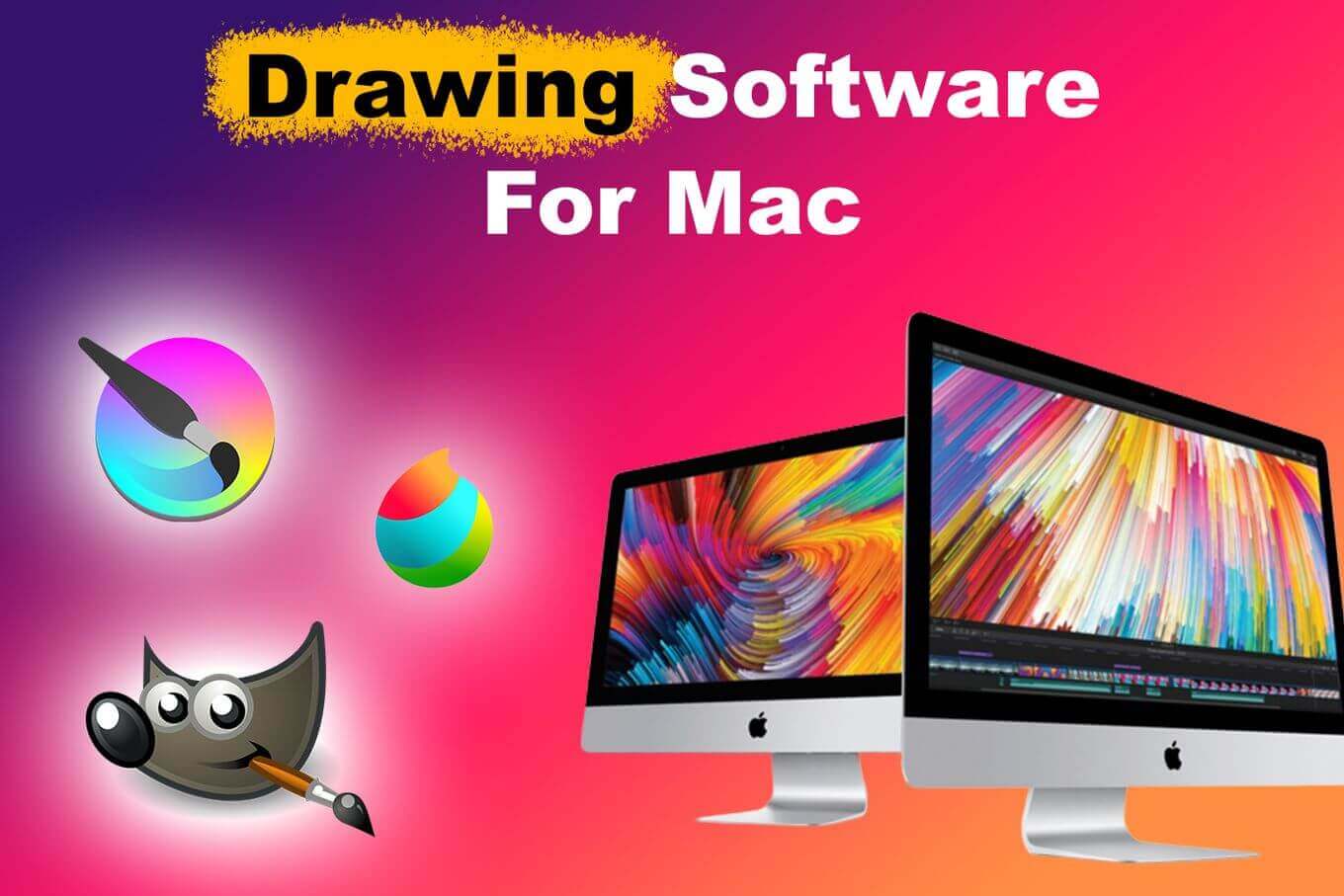In today’s digital age, artists and graphic designers have turned to technology to unleash their creativity. If you own a Mac and are passionate about drawing illustration, or graphic design, you’ll want the best drawing software available. But with so many options out there, how do you choose the one that suits your needs? This article will guide you through the best drawing software for Mac, ensuring you make an informed decision.
Why Use Drawing Software on a Mac?
Before delving into the software options, let’s understand why using drawing software on a Mac is a popular choice. Macs are known for their high-resolution displays, powerful processors, and seamless user experience. These features make them ideal for graphic work, ensuring you get the most out of your drawing software.
Key Features to Look for in Drawing Software
When selecting drawing software, keep these key features in mind:
- User-Friendly Interface
- Drawing Tools and Brushes
- Vector vs. Raster Drawing
- Advanced Features
- Customer Support
- Mobile Compatibility
- User Reviews and Ratings
Top 5 Drawing Software for Mac
1. Adobe Illustrator
- Vector Graphics: Adobe Illustrator works with vector graphics, which are based on mathematical equations and coordinates. This allows for the creation of scalable and high-resolution artwork without loss of quality.
- Drawing Tools: Illustrator provides a wide range of drawing and shape tools, including the Pen tool, Pencil tool, Line tool, and more, to create precise and intricate designs.
- Typography: It offers extensive text and typography tools for creating and formatting text in your artwork. You can also work with a vast library of fonts.
- Color and Gradients: Illustrator allows you to work with a wide color palette, gradients, and patterns. You can create custom color swatches and apply complex gradients to your designs.
- Layers: Like many design software, Illustrator uses layers to organize and manage different elements of your artwork. Layers make it easier to work with complex compositions.
- Artboards: You can work on multiple artboards within a single document, which is useful for creating different versions or variations of your design in one place.
- Image Tracing: Illustrator can convert raster images (like photos) into vector artwork through the image tracing feature.
- Export Options: The software offers a variety of export options, including the ability to save in different file formats (e.g., AI, PDF, SVG), making it versatile for different applications.
- Integration: Adobe Illustrator is part of the Adobe Creative Cloud suite, so it integrates seamlessly with other Adobe products like Photoshop and InDesign. This allows for efficient workflows and sharing of assets.
- Customization: The software is highly customizable, allowing users to create and save custom brushes, symbols, and graphic styles for easy reuse.
Adobe Illustrator is a powerful tool for both digital and print design, and it’s widely used in various industries, including graphic design, web design, advertising, and more. It offers a range of features to help designers bring their creative ideas to life in a versatile and professional manner.
2. Procreate
- Digital Painting: Procreate provides a realistic and natural painting experience with various brushes and tools. Artists can paint, sketch, and create digital artwork with ease.
- Brushes: It offers a wide variety of customizable brushes, including pencils, inks, watercolors, and more. Users can create their own brushes or download additional brushes created by the Procreate community.
- Layers: Like traditional art, Procreate uses layers to separate and organize different elements of a composition. Users can control opacity, blending modes, and masks for precise editing.
- Canvas Options: Procreate allows users to choose from various canvas sizes and aspect ratios, and they can work with incredibly high resolutions for detailed and large-scale artwork.
- Gesture Controls: The app supports a range of intuitive gestures, making it easy to zoom, rotate, and navigate through your work.
- Time-Lapse Recording: Procreate records the entire creation process as a time-lapse video, which is useful for artists to showcase their techniques or for instructional purposes.
- Animation: Procreate introduced animation capabilities in later versions, enabling users to create frame-by-frame animations directly in the app.
- Selection and Transformation: Users can select and transform parts of their artwork, allowing for easy resizing, rotating, and repositioning of elements.
- Text and Typography: Procreate offers text tools for adding and formatting text within your artwork. This is useful for creating designs with text elements.
- Export and Sharing: Artwork created in Procreate can be easily exported in various formats, including PSD, PNG, and more. Artists can share their work through social media or other platforms directly from the app.
- Community and Resources: Procreate has a vibrant online community, and there are numerous tutorials and resources available to help users learn and master the app.
Procreate is especially popular among digital artists and illustrators due to its accessibility, responsiveness, and the wide range of creative possibilities it offers. It has gained recognition for its high-quality brushes, excellent performance, and the ability to create professional-quality art on a mobile device.
3. CorelDRAW
- Vector Graphics: CorelDRAW is primarily used for creating vector graphics, which are based on mathematical equations and coordinates. This allows for the creation of scalable and high-quality designs without loss of detail or resolution.
- Drawing Tools: The software offers a wide range of drawing and shape tools, including the Pen tool, Bezier tool, and various shape tools, for creating precise and complex illustrations and designs.
- Typography: CorelDRAW provides extensive text and typography tools, allowing users to create and format text in their designs. It supports various font formats and allows for text manipulation and styling.
- Color Management: The software offers advanced color management and control, including support for Pantone colors, color harmonies, and the ability to work with various color models, such as CMYK and RGB.
- Layers: Like other graphic design software, CorelDRAW uses layers to organize and manage different elements of a design. Layers make it easier to work with complex compositions.
- Artboards: You can work on multiple artboards within a single document, making it convenient for creating different versions or variations of your design in one place.
- Image Tracing: CorelDRAW includes a feature for tracing raster images (such as photos) and converting them into vector artwork, which can be edited and scaled without loss of quality.
- Export Options: The software provides various export options, including the ability to save designs in different file formats (e.g., CDR, AI, PDF, SVG), making it versatile for different applications and industries.
- Integration: CorelDRAW can integrate with other Corel software products, and it also supports compatibility with Adobe Illustrator and other popular file formats for seamless collaboration.
- Customization: Users can create custom brushes, symbols, and styles, and the software supports third-party plugins and extensions for additional functionality.
CorelDRAW is a versatile and powerful tool for graphic design, illustration, and layout work. It is used in a wide range of applications, including print design, web design, advertising, signage, and more. Its user-friendly interface and extensive feature set make it a preferred choice for many designers and artists.
4. Affinity Designer
- Vector Graphics: Affinity Designer is primarily used for creating and editing vector graphics, which are based on mathematical equations and provide high-quality, scalable artwork without loss of detail or resolution.
- Drawing Tools: The software offers a comprehensive set of drawing and shape tools, including the Pen tool, Node tool, and a wide variety of geometric and freehand shape tools for precise and creative designs.
- Pixel Persona: Affinity Designer features a Pixel Persona that allows users to seamlessly switch between vector and raster (pixel-based) work. This is particularly useful for creating artwork that combines both vector and pixel elements.
- Typography: It provides robust text and typography tools for adding, formatting, and styling text within your designs. You can work with a wide range of fonts and formatting options.
- Color Management: Affinity Designer offers advanced color management and control, including support for Pantone colors, global color swatches, color harmonies, and compatibility with various color models (CMYK, RGB, etc.).
- Layers: Like most graphic design software, Affinity Designer uses layers to organize and manage different elements within your designs, allowing for easier editing and organization.
- Artboards: Users can work on multiple artboards within a single document, making it convenient for creating different versions or variations of a design in one place.
- Export Options: The software provides various export options, including support for multiple file formats (e.g., SVG, PDF, PSD), ensuring compatibility with different applications and platforms.
- Non-Destructive Editing: Affinity Designer features non-destructive effects and adjustment layers, allowing you to make changes to your designs without permanently altering the original content.
- Asset Management: You can create and manage design assets, such as symbols, brushes, styles, and more, for efficient reuse in your projects.
- Cross-Platform Compatibility: Affinity Designer is available for macOS, Windows, and iPad, with seamless file compatibility across platforms.
Affinity Designer is known for its high-quality performance and extensive feature set, making it a strong competitor to industry-standard graphic design software. Its one-time purchase model and affordable pricing make it an attractive option for both professionals and hobbyists in the design and illustration fields.
5. Autodesk SketchBook
utodesk SketchBook is a popular digital drawing and painting application designed for artists, illustrators, and anyone who enjoys creating digital artwork. It is available on various platforms, including Windows, macOS, iOS, and Android, making it accessible to a wide range of users.
Key features of Autodesk SketchBook include:
- Intuitive User Interface: SketchBook offers a user-friendly interface with a clean design, making it easy for both beginners and experienced artists to navigate.
- Brushes and Tools: The application provides a wide variety of customizable brushes and tools that can be used for digital painting and drawing. Users can adjust the settings of these brushes to achieve different textures and effects.
- Layer Support: Like many other graphic design applications, SketchBook supports multiple layers, enabling users to work on different elements of their artwork separately and make non-destructive edits.
- Color and Blending Options: Users have access to a comprehensive color palette and blending modes to create stunning color transitions and effects.
- Symmetry Tools: SketchBook offers symmetry tools, which are particularly helpful for creating symmetrical designs and patterns.
- Guides and Rulers: The application includes a variety of guides and rulers to help artists maintain precision in their work.
- Export and Share: Users can easily export their work in various file formats, including PSD, JPG, and PNG. SketchBook also allows for quick sharing on social media platforms directly from the application.
- Customizable Workspace: Artists can customize the workspace to suit their preferences, rearranging tools and palettes for a personalized setup.
- Cross-Platform Sync: SketchBook provides cloud storage, which allows users to sync their work across different devices, ensuring that their creations are always accessible.
- Free and Paid Versions: Autodesk offers both a free and a paid version of SketchBook. The free version provides most of the core features, while the paid subscription offers additional brushes and tools, more layers, and advanced features.
Autodesk SketchBook has gained popularity in the digital art community due to its powerful features, ease of use, and its availability on multiple platforms. It is widely used for creating digital illustrations, concept art, comic book art, and more. Whether you’re a professional artist or just getting started with digital art, SketchBook is a versatile and capable tool to explore your creative potential.
Pricing Comparison
When choosing drawing software, consider your budget. Adobe Illustrator and CorelDRAW come with subscription plans, while Procreate, Affinity Designer, and Autodesk SketchBook offer more cost-effective options, some with one-time purchase fees.
User-Friendly Interface
A user-friendly interface is essential for a smooth drawing experience. Adobe Illustrator and Procreate are known for their intuitive design, making them accessible to both novices and experts.
Drawing Tools and Brushes
The variety and quality of drawing tools and brushes can significantly impact your work. Procreate stands out for its extensive library of brushes, while Adobe Illustrator and CorelDRAW offer a wide array of versatile tools.
Vector vs. Raster Drawing
Consider whether you need vector or raster drawing. Vector drawings are scalable without quality loss, while raster drawings are pixel-based. Adobe Illustrator excels in vector graphics, while Procreate and Autodesk SketchBook are more focused on raster drawing.
Advanced Features
Depending on your projects, advanced features like animation, 3D modeling, collaboration, and cloud integration may be crucial. Adobe Illustrator, CorelDRAW, and Autodesk SketchBook offer advanced capabilities in these areas.
Customer Support
Good customer support can save you a lot of headaches. Adobe, Corel, and Autodesk have well-established customer support teams, while Procreate and Affinity Designer rely on their user communities.
Mobile Compatibility
If you’re often on the go, consider the software’s mobile compatibility. Procreate and Autodesk SketchBook have mobile versions, allowing you to work from your iPad or iPhone seamlessly.
User Reviews and Ratings
Before making your final decision, check user reviews and ratings. These insights from real users can provide valuable information about the software’s performance and reliability.
Conclusion
Choosing the best drawing software for your Mac depends on your specific needs and preferences. Each of the mentioned software options has its strengths and can help you create beautiful artwork. Consider your budget, the type of work you do, and your level of expertise before making your choice. With the right software, you can unlock your full creative potential on your Mac.
Frequently Asked Questions (FAQs)
1. Can I use these drawing software options on older Mac models?
Yes, most of these software options are compatible with a range of Mac models. Check the system requirements for each to ensure compatibility.
2. Are there free drawing software options for Macs?
Yes, there are free options like GIMP and Inkscape, but the features may be more limited compared to paid software.
3. Do I need a stylus or drawing tablet to use these software applications effectively?
While not mandatory, a stylus or drawing tablet can greatly enhance your drawing experience, providing more precision and control.
4. Can I export my work in different file formats using these software programs?
Yes, all the mentioned software options allow you to export your work in various file formats, ensuring compatibility with other design and editing tools.
5. What is the best software for a beginner looking to get into digital art?
For beginners, Procreate and Autodesk SketchBook are great options due to their ease of use and robust toolsets.






